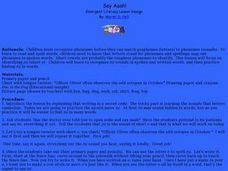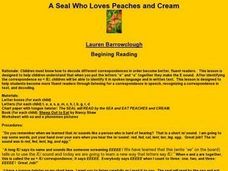Curated OER
First Letter Changes
Students use the books of Eric Carle to change the first letter in a word to see a new word. In this phonics lesson plan, students change the beginning letters in poems and books.
Curated OER
Picture Match
Pupils match pictures with words that have specific phonics connotations. In this picture matching lesson plan, students have groups of words with the same phonics sayings.
Pennsylvania Department of Education
Writing With Environmental Print
Learners develop literacy skills by exploring street signs, cereal boxes, and billboards. For this writing with environmental print lesson, students build word recognition in every day print. Learners decode words and discover new words.
Curated OER
Say Aaah!
Pupils complete a variety of activities as they explore/review the letter 'o' as it makes the short /o/ sound. They recite short /o/ tongue twisters and practice writing the letter 'o'. They rewrite 'Skip to My Lou" using short /o/...
Curated OER
Tracking Rubric
In this assessment instructional activity, students read a tracking rubric. The rubric includes the following skills: code knowledge, blending for reading, segmenting for spelling, reading irregular words, and spelling irregular words.
Curated OER
Bump on the Head
Students discuss as a class if they have ever had a bump on the head and started crying and said /a/. They pretend they have hit their head and say the /a/ stretching it out and try a tongue twister containing the sound and write the...
Curated OER
"Aaaaaa!!!!" Please Don't Cry Baby!
Learners complete a variety of activities as they examine the letter 'a' as it makes the short /a/ sound. Through instruction and modeling, they explore the sound the letter makes and how the letter is written. They recite tongue...
Curated OER
Abra-kadabra-kazam /a//a//a/, POOF!
First graders discover that each letter of the alphabet has a sound then detect the /a/ sound represented by the letter a. They pretend to be magicians and say, "Abra-kadabra-kazam! POOF!" emphasizing the /a/ sound and then repeat an /a/...
Curated OER
Math: Congruent and Similar Figures
Eighth graders use geo-boards to create similar and congruent figures and find their corresponding sides. Using the geo-board paper, they draw the shapes they create on the geo-boards. With partners,students create similar and congruent...
Curated OER
Slippery Sammy the Seal
Students examine the letter 's'. Through instruction and modeling they explore the sound the letter makes, how the letter is written, words that contain the letter, etc. They say tongue twisters with the /s/ sound in them. They read...
Curated OER
The See-Saw: How to Blend
First graders listen as the word "cat" is sounded out spreading out all the sounds contained. They discover the meaning of blending using the word "cat" and then changing the consonants to make new words. They then figure out new words...
Curated OER
Aaaaa! A Monster!
Students complete a variety of activities as they examine the letter 'a' as it makes the short /a/ sound. Through instruction and modeling, they explore the sound the letter makes and how the letter is written. They recite tongue...
Curated OER
Initial Consonant Clusters
In this literacy activity, students look for the words that correlate to the pictures that are listed. They are all words that are consonant clusters.
Curated OER
Women in History
Students discuss the impact women have made on the United States. Individually, they choose two women to research on the internet to discover their contributions. They develop a PowerPoint slide to be combined with ones made by their...
Curated OER
Science: Why Animals Hibernate
Second graders investigate the reasons animals hibernate. They measure their own heart rates and compare them to those of a hibernating bear. In their journals, 2nd graders record facts about and characteristics of hibernation and...
Curated OER
A Seal Who Loves Peaches and Cream
Learners decode correspondence in order to become better, fluent readers. When the letters e and a are put together they make the E sound. They become more fluent readers through listening for a correspondence in speech, in text, and...















